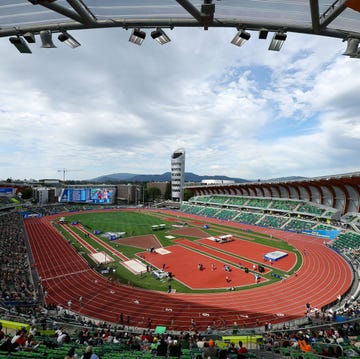If the summer of 2024 were anything like the summer of 2021, the last time the U.S. Olympic Trials were held, six-time NCAA champion Parker Valby would have announced a pro deal by now. She’d be racing in the uniform of her shoe sponsor, and she’d likely have a new coach and a new training group.
But she’s not—she’s still racing in her University of Florida kit, even though she is done running for Florida and turning pro. When she was asked about it after the 5,000 meters at the Trials, where Valby finished fourth, she did not give any information.
“When do you think a decision about a professional deal is going to come for you?” Jonathan Gault, of LetsRun, asked her.
“When it comes,” Valby replied.
What’s taking so long? Valby had an NIL (name-image-likeness) deal with Nike, which she signed last summer. And even though NIL deals usually end when college competition ends, sources familiar with Valby’s situation say language in her NIL contract gives Nike the right to match offers from any other brands for her pro deal.
Nike did not immediately respond to a request for comment from Runner’s World.
These clauses, which give an NIL brand first dibs on an athlete’s pro contract, are increasingly common with distance runners. Brands, waging recruiting wars for top college talent, use NIL to get any early start.
Runner’s World spoke to four agents, two sports marketing reps at large shoe companies, and two coaches, and none wanted to be quoted on the topic. But they all acknowledged that companies are giving the best distance runners NIL deals with the expectation—sometimes written into the NIL contract—that they’ll get the first crack at signing them when they go pro.
Typically, brands aren’t using the athletes they sign for much marketing while they’re still in college. Nathan Green, for instance, a miler at the University of Washington who finished fifth in the 1500-meter final at the Trials, has an NIL with Adidas, he said after the race. But there’s little public sign of the arrangement. Washington is an Adidas school, so Green’s race photos show him in Adidas gear, but Green doesn’t mention the company in his Instagram bio. Liam Murphy, a Villanova runner who was 11th in the 1500 final, said he has a Kiprun NIL, but there’s no sign of it in his social media, either.
If brands aren’t using college athletes’ images for marketing, it would seem the primary reason they’re signing them to NIL deals is to get a jump on them for their pro careers. On, for instance, had NIL deals with Harvard’s Maia Ramsden, Notre Dame’s Olivia Markezich, and Stanford’s Ky Robinson. All three were recently added to the On Athletics Club that trains in Boulder, Colorado, under Dathan Ritzenhein.
It’s not clear whether On’s NIL contracts included language that gave the company the right of first refusal or whether the company had simply established a friendly relationship with those runners while they were in college. A representative for On did not immediately respond to a request for comment from Runner’s World.
Any of those accomplished runners would have drawn interest from other brands. Sources told Runner’s World that Markezich, for instance, visited at least two teams sponsored by other companies. But On, it appeared to observers, had the inside lane on the 2023 NCAA steeplechase champion.
Athletes are taking in a lot of money when they’re in the NCAA—and more when they go pro. Generally, NIL has been seen as a boon for college runners (and also the agents who negotiate those NIL deals). And to be sure, sometimes the company they sign with for an NIL is the best fit for them as pros.
But are athletes who sign NILs then maximizing what they could get after college? Probably not. Some brands hesitate to make a competing contract offer if they know another company has the right of first refusal. And an agent won’t necessarily solicit outside offers, either. So athletes can get “stuck” with the company they signed an NIL with, one coach said, probably for less money than they could get if they didn’t have a preexisting relationship with a brand through NIL. Competition drives pay higher.
That’s especially true for athletes who have a breakthrough after they sign an NIL. Valby is a good example. When she signed with Nike, she had not yet won an NCAA title. Since that time, she has won six and intrigued running fans with her unconventional training, which includes intense cross-training.
It’s important for college athletes and their parents to read the fine print if athletes are presented with NIL opportunities, especially as NIL rules are frequently changing and vary from state to state, said Cara Hawkins-Jedlicka, assistant professor in the Edward R. Murrow College of Communication at Washington State, who studies NIL.
“As NIL opportunities grow, brands will ask for more. Athletes need to think carefully about what’s best for them, both now and in the future,” Hawkins-Jedlicka said. “As legal challenges arise and guidelines change, recent grads and current college athletes are stepping into unfamiliar territory. They’re navigating a landscape that’s reshaping itself even as they move through it, trying to find the best way forward for their careers.”

Sarah Lorge Butler is a writer and editor living in Eugene, Oregon, and her stories about the sport, its trends, and fascinating individuals have appeared in Runner’s World since 2005. She is the author of two popular fitness books, Run Your Butt Off! and Walk Your Butt Off!













